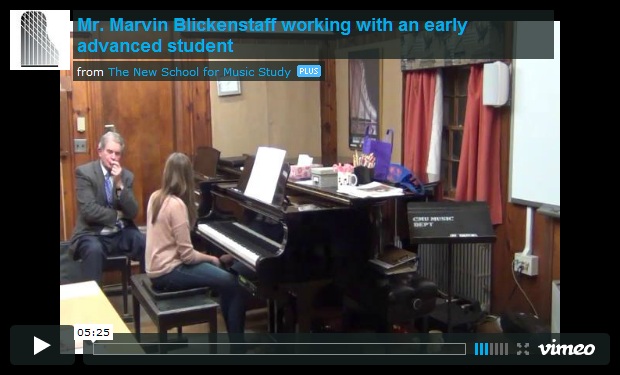Teaching Inspiration: Marvin Blickenstaff
Two years ago, I had the privilege of meeting Marvin Blickenstaff at the New School for Music Study in Kingston, NJ. I was in the second year of my masters at Eastman and was researching piano pedagogue and innovator, Frances Clark (Co-Founder of the New School) for a final project. As part of my research, I visited the New School for several days, met with the faculty, observed lessons and classes, and experienced truly excellent teaching. At the end of my first day, after observing a lesson with Marvin, I wrote this reflection:
Marvin Blickenstaff, and high school PEPS [Program for Excellence in Piano Study] student, Grace, were already in the midst of Chopin’s Etude in C Minor when I snuck in to observe. Together, they identified the salient motives, determined the differences between the lines of each hand, rehearsed the rhythmic structure, and discussed Chopin’s individualistic thoughts on trills. Similar to the other faculty members, Marvin sought answers from Grace by asking questions and engaging her in conversation about the music. Comments such as, “Talk to me about the fingering in this scale” when working on the first page of the Pathetique Sonata and, “What are four ways you are going to practice this?” assessed Grace’s understanding and encouraged dialogue.
At the end of the second day, I observed one of PEPS group class with Marvin:
PEPS students meet in small rotation groups every few weeks and in a larger group class of eight students once per month, each an hour in length. Currently, there are 24 students in the program. Marvin began each class with scales, often asking two students to play in ensemble: one ascending and the other descending. The students had end-of-the-year fluency goals posted in the room: 100-160, depending on age and ability. Repertoire included Debussy, Clementi, a Mozart minuet (where Marvin led the students in an impromptu minuet around the room while singing words that fit the melody), a Bach invention, a concerto by Vandall, and lastly, Sibelius’ Romance, to which Marvin stated, “Begin warm, soft, calm, and with a feeling of moonlight. . . Music that is calm is even.” Musical discussions included historical influences, theoretical considerations such as the importance of the cadential 6/4 progression, and phrasing decisions supported by careful pedaling. Students were challenged in thought, touch, and sound.
These few days had a profound impact on my teaching. I love reliving the experience through my notes and recollections of those lessons and classes. I was thrilled to discover www.pianopedagogy.org last week – the NSMS’s newest venture! Complete with teaching videos, tutorials, and a blog written by New School faculty, this website is a great source of knowledge and teaching inspiration. Enjoy this glimpse of a lesson with Marvin as he coaches an early advanced student on Edvard Grieg’s “Notturno” at the New School:
Previously: Notes from the New School – Day 1 Notes from the New School – Day 2 Notes from the New School – Day 3
